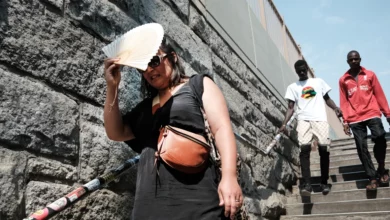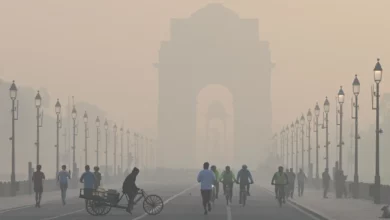Notorious for being one of the most polluted areas in Greater Cairo, Shubra el-Kheima is on the verge of seeing yet another factory built within the district’s intermingled residential and industrial zones.
News of the project–a fuel oil refinery that will produce high quality diesel oil–sparked outrage among local residents, and a popular campaign, dubbed Itkhana’na ("We’ve Suffocated"), was quickly put together in June 2008 aimed at opposing the plan.
Over a year and a half later, the campaign continues to fight on. But while its coordinators claim to have succeeded at delaying the project, they also admitted that construction had quietly commenced earlier this year.
“The government seems bent on this factory’s operation,” said lawyer and campaign coordinator Ahmed el-Naggar. El-Naggar and others in the "Popular Committee to Save Shubra el-Kheima from Pollution"–which initially organized Itkhana’na–fear that the health and environmental impact of the factory will prove catastrophic.
Behind its construction is the Egyptian Refining Company (ERC), majority shares of which are owned by local and Arab investors led by private equities firm Citadel Capital. The refinery will be housed within the parameters of a major preexisting plant belonging to the Cairo Oil Refining Company (CORC).
“Essentially, they’re building a factory within a factory,” said el-Naggar, who believes the reason for this is to bypass the difficulties associated with obtaining a permit to construct a standalone factory in the area.
However, according to CORC spokesperson Ibrahim Mabrouk, "efficiency" is the reason cited for sharing the premises.
“The new factory will be directly fed by one of our products, fuel oil, which will be processed to produce diesel,” Mabrouk explained. He added that the two plants would also share other resources that would serve to reduce transport costs and pollution levels. He also asserted that construction had not yet begun.
Citadel Capital officials said they do not disclose information about projects before their completion. Nevertheless, its website states that construction is slated to begin in 2011, with the plant expected to be fully operational by the end of 2013.
Yet for campaign leaders, questions about the site itself are secondary to the legal aspects of the case.
Mohamed Abdallah, another Itkhana’na coordinator, said that the public hearing legally required for the construction of any such project was a sham.
“First of all, the hearing was held within the walls of [the CORC]," he said. "And secondly, none of the local people invited had a clue as to what was being discussed.” In fact, both el-Naggar and Abdallah claim that the project owners had hired people to attend the October 2008 hearing, instructing them to “just clap when others speak.”
Abdallah went on to assert that some families had been given LE50 and sandwiches in return for their attendance–with the exception of one woman who purportedly stood up in the middle of the hearing and loudly demanded her money.
Campaign organizers also entertain doubts as to the integrity of the Environmental Impact Assessment (EIA), issued by Cairo University, undertaken in advance of the project.
“The company commissioned the university and paid for the study itself,” said el-Naggar, pointing out how the arrangement defeated the purpose of an independent analysis of the project’s potential effects. “So was it any surprise that the study supported the project?”
A subsequent report released by the Institute of Environmental Studies and Research at Ains Shams University contested the validity of the EIA, drawing attention to the lack of data and highlighting inaccuracies.
“The EIA states that the project is situated over 40km from downtown Cairo, yet, in reality, it is 14.5km from Ataba Square [in the heart of downtown Cairo],” the report states. It goes on to ask what would become of the more than 500 tons of waste the plant is expected to produce every hour.
Moreover, given the factory’s proposed location, the report states that wind patterns would channel air pollution emitted by the plant towards major residential areas as little as 3km away, as well as the Zeitoun and Heliopolis districts–the latter being “home to the head of governance,” noted el-Naggar with irony.
Nevertheless, according to the ERC, as of June 2009, the project had received preliminary approval from the Ministry of State for Environmental Affairs. When asked by Al-Masry Al-Youm, however, Environment Ministry officials refrained from confirming that this was the case.
Yet the effects of air pollution, which are noted by both campaign organizers and in the Ain Shams report, pale in comparison to the anticipated impact on the area’s supplies of drinking water. The factory is expected to consume 6200 cubic meters of water from the Ismalia Canal every hour–some 155,000 cubic meters per day–for cooling purposes, before pumping it back out.
“The chemicals pumped back into the canal with the contaminated water are not the sort that can be treated by a water plant’s filter systems or by adding a bit of chlorine,” said el-Naggar. “Nothing will be able to stop these chemicals from doing untold damage to the local community’s health in the long run.”
The Ain Shams report concurs with this analysis: “Water plants that treat intake from this canal are found from Mostroud to Ismalia, and they will not be able to process some of the [contaminants] in the factory’s wastewater.”
Yet according to a separate report issued by the ERC, waste water pumped back into the canal will first undergo a three-stage treatment process in line with international standards. The report goes so far as to assert that the plant’s operations will actually serve to improve overall air quality in Cairo by preventing some 93,000 tons of sulfur from being released by the CORC’s more antiquated factories.
Indeed, for Mabrouk, the real environmental threat is posed by the many unlicensed and unregulated residential areas that have sprung up around the factory since its establishment in 1969. “You see people burning coal and wood outside our factory walls, oblivious to the fact that this a petroleum plant,” he said. "That’s the real catastrophe."
Until now, the campaign’s primary challenge has been to raise awareness of the factory’s potential impact among a community far more concerned with meeting everyday needs. “For most people we speak to, ideas like cancer and air pollution are the last thing on their mind,” said Abdallah.
Nonetheless, the campaign continues to try to convey its message to the wider public. Its next step will be to hold a conference aimed at raising local awareness about the Ain Shams report. Campaign organizers are also in the process of preparing a summary of the study to be distributed to area residents.




